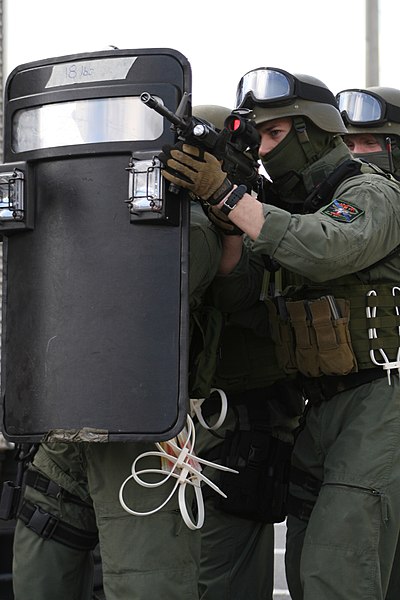Note: For the sake of brevity, I will use the term “ballistic shields” to be an all-inclusive term for III-A rated shields used by law enforcement.
Even the Ballistic Resistant Protective Materials NIJ Standard 0108.01, a publication that is used by the U.S. Department of Justice, warns of highly technical jargon that may be confusing for the uninitiated when defining a ballistic shield:
“Because this NIJ standard is designed as a procurement aid, it is necessarily highly technical. For those who seek general guidance concerning the selection and application of law enforcement equipment, user guides have also been published. The guides explain, in non-technical language, how to select equipment capable of performance required by an agency.” – Lester D. Shubin, Program Manager for Standards, National Institute of Justice.
Related video:

An edge for the Thin Blue Line
Imagine, for a moment, a metropolis of crowded buildings, hours after nightfall. Strobes of red and blue paint the virtually empty streets. Police vehicles and personnel are poised with a single structure at their center. Negotiations are faltering, their demands are too ambitious, and the hostages are too far out of reach.
Your uniform declares “Special Weapons and Tactics” to the world. Your radio comes to life and the order is issued. Everyone is on high alert for what may happen next.
Leading a four-man formation with a shield and side arm, you glide, skirting the wall, right up to the front door. The second team arrives behind your stack. Protected by eyes and weapons pointed in all directions, you check the handle:
Locked.
After a moment of communication with a team member known as the breacher, he crosses to the opposite end of the door. You feel someone squeeze your arm; that’s the signal. You make eye contact with the breacher and he gives you a nod. The adrenaline pumping through your veins fuels a moment of clarity: You trained for this. You are ready for this. It’s time to lay down the f *cking law.
Every hallway, room, and staircase are methodically cleared using slow, but deliberate movements. Your shield never lowers, but the weight begins to take its toll on your strength.
Hostiles attempt to repel your advance by firing everything they’ve got. The roar of .44 magnums and 9mm pistols fill the air. Whatever your ballistic shield doesn’t block impacts around you.
You return the greeting — with interest — and push forward.
The outside world holds their breath, transfixed on the live-stream broadcast. The eyes of millions scan for every flash, boom, and bust from the safety of their phones. After what feels like an eternity, your team and the hostages emerge.
This is one of countless scenarios that law enforcement faces as “the thin blue line” separating the civilized world from the savagery of gangs and terror. Ballistic shields give officers an edge against an enemy that would otherwise prey on the innocent with impunity.
Could this edge be transferable to the battlefield?
First, its cumbersome size and weight reduces a rifleman’s speed and mobility — two very important traits that are not easily sacrificed by warriors. It’s always better to dodge a bullet than to block it (for obvious reasons). A modern troop will be equipped with heavy gear, ammo, and a chest full of patriotism.
The ballistic shield is lightweight only in the sense that it weighs under 20 pounds.
It just becomes another thing to lug around with no comfortable method of carry. It would be another asinine piece of gear that could potentially get you killed because some congressman and a defense firm shook hands. Firefights can sometimes last hours, days, or (in some of the most brutal circumstances) months, and you can literally and metaphorically find yourself fighting single-handed.
Second, unconventional enemies use high-caliber, armor-piercing rounds. Most of what you would find when fighting communists or terror organizations would turn a ballistic shield into Swiss cheese.
You won’t find the Islamic State imposing their twisted ideologies with a 9mm. An Improvised Explosive Device buried underneath the ground will effectively neutralize any benefit of that additional armor.
Third, most battles don’t devolve into a “Mexican Stand-Off,” sealed away from the rest of the city. If the enemy is fortified, but there are no hostages or prisoners of war, there are other options…
Ballistic shields have earned their place as a staple for law enforcement because they have a specific purpose. Those same shields offer little to no benefit in combat.


